Our four residences, built at the turn of the century, are named after the British cathedral cities of Canterbury, Salisbury, Truro and Winchester. Lincoln and Bangor, now no-longer residences, were also named after famous cathedral cities. Please read a bit about our rich heritage below.
Visit the Cathedral or City of Canterbury or experience their Virtual Tour.
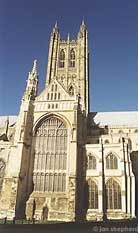
Canterbury Cathedral
Canterbury has been a popular place to visit for centuries and remains so today. From humble pilgrims to Roman battalions to Royalty, Canterbury has been an important visiting place throughout the centuries and is one of the few places that can trace unended occupancy throughout known history. Situated in Kent in the South East of England, it is accessible for all. It is only 90 mins by train from London, about 90 mins to cross the English Channel or 2 hrs from Paris on Eurostar.
The small medieval city, with a population of only 33000, exudes a warm and friendly atmosphere. The contrasts between old and new can be seen in it's medieval architecture and modern shops You can stroll down quaint streets lined with intricately carpented leaning houses or take in the ambience of the city from a boat while gliding down the River Stour.
The most striking figure when nearing Canterbury is the medieval Cathedral. It towers over the city at an impressive height of 537 feet. Canterbury is the centre for the founding of English Christianity.The Cathedral gives Canterbury it's fame as the head church for the Anglican Faith throughout the world. It was for christianity that St. Thomas Becket died, thus giving Canterbury pilgrimage status and thousands journey from far and wide to pay homage to the martyr.
The first Archbishop of Canterbury was St Augustine who arrived on the coast of Kent as a missionary to England in 597 AD. He came from Rome, sent by Pope Gregory the Great.
The story goes that Gregory had seen "Angle" slaves for sale in the city market and struck by their beauty, had remarked "not Angles but Angels". Such a people he was convinced should be converted to Christianity, and ordered Augustine and a group of monks to set out for England.
On his arrival Augustine was given a church at Canterbury by the local King Ethelbert whose Queen, Bertha, was already a Christian. This building had been a place of worship during the Roman occupation of Britain.
Soon consecrated Bishop, Augustine established his seat (or "cathedra") in this place as the first Archbishop of Canterbury. The present archbishop, Most Revd Dr Rowan Williams, is 104th in the line of succession.
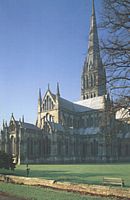
Salisbury Cathedral
Visit the Cathedral or City of Salisbury or experience their Virtual Tour.
The Cathedral Church of the Blessed Virgin Mary in Salisbury is unique amongst medieval English cathedrals, built within one century with no substantial later additions. The building itself is remarkable, a testimony to the faith and practical skills of those who erected it.
Salisbury is one of the finest medieval cathedrals in Britain. It is the mother church of the Salisbury Diocese, an area which covers most of the counties of Wiltshire and Dorset.
Started in 1220 it was completed by 1258, with the Spire, the tallest in England (123m/404ft) added a generation later. Built to reflect the glory of God in stone and glass, it has always been a setting for great occasions, for huge colourful processions, a majestic and awe-inspiring church - as it has done for over 775 years.
Visit the Cathedral or City of Truro or experience their Virtual Tour.
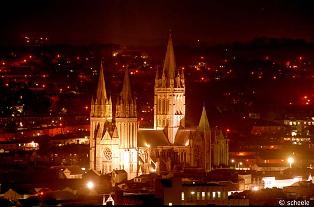
Truro Cathedral
Truro has a very recent foundation, the first part of the Cathedral being consecrated in 1887, seven years after the laying of the foundation stones in 1880, and the whole building only coming to completion in 1910, when the Western Towers were dedicated.
It is the first Cathedral in Britain to be consecrated after the Reformation, and one of great architectural merit, being the masterpiece of John Loughborough Pearson. J. L. Pearson died in 1897, ten years after the consecration. The work was continued by his son, Frank Loughborough Pearson.
Pearson’s avowed aim was to build a Cathedral which “will bring people soonest to their knees”. He has done just that – and the grace and grandeur of the building is quite remarkable for its scale and size. The style of the building was influenced by Pearson’s travels in Normandy and Brittany, and just as Cathedrals there rise out of the centre of their towns and cities, Truro too rises majestic from the very heart of the commercial city. The foundations stones were laid in 1880 by the then Prince of Wales, who later became King Edward VII.
Incredibly, the whole endeavour of building a new Cathedral for Cornwall had taken a mere three decades to complete, and at a time when the Cornish economy was undergoing one of its many declines.
The Cathedral houses some very great treasures, the most outstanding among them being the most wonderful series of stained glass windows by Clayton and Bell, and the world-famous Father Willis Organ. The windows contain some of the greatest examples of Victorian stained glass in the world, and the Organ is a marvel of co-operation between an architect and an organ builder. People from all over the world come to see and hear the organ, which, set in its unusual stone vaulted chamber, has a particularly fine sound. It was built in 1887 and is one of the finest in the country, an instrument of great power and brilliance.
Visit the Cathedral or City of Winchester or experience their Virtual Tour.
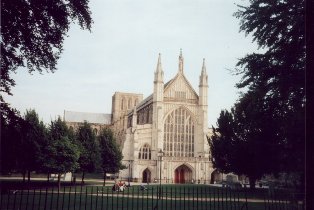
Winchester Cathedral
There has been a Cathedral in Winchester since about 648 AD. The foundations of the current Cathedral were laid out in 1079 by Walkelin, the first Norman Bishop. To this new building (consecrated in 1093) the relics of St. Swithin were solemnly transferred, 15 July, and the "Old Minster" was torn down. The Norman Cathedral measured 535 ft (164m) in length, the longest ten in existence. This is 13m longer than the present structure, the Norman towers at the West front were removed about 1350.
Before that, there were problems. Proposed towers on the transept ends were abandoned due to poor ground conditions, and in 1107 the central tower collapsed. Between 1905-12 William Walker, the diver, worked with 150 others to underpin most of the cathedral walls.
Within its walls took place the burial of William Rufus (1100), the coronation of Richard I (1194), the marriage of Henry IV (1401), and the marriage of Queen Mary (1554).
In its 900+ year history the Cathedral has been much remodelled and extended. In 1202 the retrochoir (The lower roofed section on the East front in the picture above left), was begun. Between 1350 - 1410 the West front was rebuilt and the Nave remodelled in the Perpendicular style. This was accomplished by cutting the Norman stonework in-situ and recasting the piers. The elevations were altered from the original 3 storey work into 2 storey by cutting out the heads of the Norman arched arcade and resetting them at a higher level. The whole Nave was also re-vaulted at this time. In 1500 the East bay of the Lady chapel was rebuilt.
In truth it is impossible to adequately detail even a small portion of the Cathedral’s history, the many changes it has undergone, and the wealth of beautiful treasures it contains. Many of the ancient Kings of England are buried here, alongside Saints, Bishops, and many notable `commoners´, such as Jayne Austen and Izaac Walton. The 12th century `Winchester Bible´, font and wall paintings have survived, along with many other later works of art.
Visit the Cathedral or City of Lincoln.
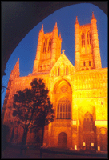
Lincoln Cathedral
In 1092 the Cathedral at Lincoln built by Bishop Remigius was consecrated. Remigius, a Benedictine monk and supporter of William the Conqueror at the Battle of Hastings in 1066, was the first Norman Bishop of the largest diocese in medieval England, extending from the Humber to the Thames. The Cathedral of this diocese had been at Dorchester, near Oxford, but in 1072 William instructed that the Bishopric should be moved to Lincoln. A castle had already been established in Lincoln by William located in the South-West corner of the old Roman upper city. The new Cathedral was built of Lincolnshire oolitic limestone opposite the castle in the South-East corner.
In 1141, or possibly earlier, the Cathedral was damaged by fire. Alexander 'the Magnificent' (Bishop of Lincoln, 1123-48) partially rebuilt the damaged Cathedral. Educated in Laon in northern France, Alexander travelled widely and was acquainted with the most advanced architecture of his day. Henry of Huntingdon, who compiled his 'History of the English' at Alexander's request, states that the Bishop restored the Cathedral with such subtle workmanship that it was more beautiful than before, and second to none in England.
An earthquake caused structural damage to Lincoln Cathedral in 1185. St Hugh (Bishop of Lincoln, 1186-1200) began work on reconstructing the Cathedral in 1192. He used the Gothic style, where pointed arches (rather than round ones), ribbed vaults and flying buttresses made it possible to make larger windows (for stained glass) and larger roof spans. St. Hugh himself was said to have carried a hod to help with the building work, but he died in 1200, before the great Transept and Nave were finished.
Given the experimental nature of Gothic architecture, mistakes occurred, and the central tower's collapse in 1237 or 1239 was a major setback. A new tower was started immediately and in 1255 the Dean and Chapter petitioned Henry III to allow them to take down part of the extended town wall to enlarge the Cathedral. They replaced Hugh's rounded chapels with a larger and loftier square east end to provide more space for the increasing numbers of pilgrims venerating the saint's shrine. This Angel Choir was consecrated in 1280.
Between 1307 and 1311 the central tower was raised to its present height. Then around 1370 to 1400 the western towers were heightened. All three towers had spires until 1549 when the central tower's spire blew down.
The weight of the western towers and spires caused them to lean, and around 1730 the architect James Gibb added cross walls for strengthening, creating a Narthex within Remigius's remaining bay behind the west front. The western spires remained until 1807, when they were removed for safety reasons, resulting in the Cathedral we see today. Extensive maintenance is required on the fabric of the Cathedral. Conservation work on the northern run of the Romanesque Frieze on the West Front was completed in 2000.
In the spirit of the Inns of Court in England, Lincoln House at Rhodes University is now home to the Law Faculty.
Visit Bangor Cathedral or the City of Gwynedd.
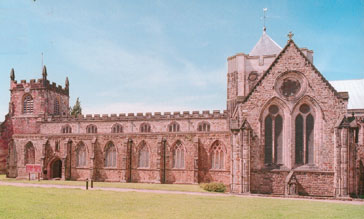
Bangor Cathedral
Not to be confused with Bangor in the USA, which is known as the town where many Stephen King stories take place, Bangor in Gwynedd, North Wales, is one of the smallest cities in the UK. It is a university town and has a population of roughly 20,000 of whom about a third are students. The origins of the city date back to the founding of a cathedral by the Celtic saint Deiniol in the 7th century AD (or thereabouts). The name 'bangor' itself comes from a Welsh word for a type of fenced-in enclosure, such as was originally on the site of the cathedral. The present cathedral is a somewhat more recent building and has been extensively modified throughout the centuries. While the building itself isn't the oldest, and certainly not the biggest, the bishopric
Not to be confused with Bangor in the USA, which is known as the town where many Stephen King stories take place, Bangor in Gwynedd, North Wales, is one of the smallest cities in the UK. It is a university town and has a population of roughly 20,000 of whom about a third are students. The origins of the city date back to the founding of a Cathedral by the Celtic saint Deiniol in the 7th century AD (or thereabouts). The name "bangor" itself comes from a Welsh word for a type of fenced-in enclosure, such as was originally on the site of the Cathedral. The present Cathedral is a somewhat more recent building and has been extensively modified throughout the centuries. While the building itself isn't the oldest, and certainly not the biggest, the bishopric of Bangor is one of the oldest in the UK. Another claim to fame is that Bangor allegedly has the longest High Street in Europe.
Also in North Wales, but close to the English border, is the somewhat smaller Bangor-Is-Y-Coed (which literally means Bangor Below The Trees, but in English is usually called Bangor-On-Dee).
Bangor Cathedral, situated on the south side of the Menia Straits which separates the isle of Anglesey from the mainland of north Wales, may be the only Cathedral in the United Kingdom to have been in continuous use since its conception. It is one of the earliest monastic settlements in all of the UK. being founded by St. Deiniol in the year 525; when Deiniol was consecrated Bishop in 546 his church became a Cathedral.
Four Bishops of Bangor have gone on to be Archbishop's of Canterbury.
The building one sees today is of course not the original, for the Cathedral has been rebuilt on several occasions. The first stone one being erected by Bishop David between ll20 and ll39.
The 'Cathedral' has suffered immense damage throughout its history having been severely burnt on several occasions, both during local conflicts between the Princes of Gwynedd and by them against 'Longshanks' Edward Ist of England.
In 1402 it suffered severe damage once again when Owain Glyndwr made his advance into the north; for it was garrisoned by English troops and their fight to retain it was bitter; with Owain losing many men.
Then again late in l5th century extensive rebuilding was again undertaken, for the Cathedral had suffered saver damage during the English Civil War. Finally in the nineteenth century, Sir Gilbert Scott was asked to supervise a drastic restoration. It is the result of his endeavours which can be seen today; a Victorian creation which completely hides any part of the original Cathedrals that once stood on this hallowed turf.
Despite all the destruction and rebuilding which has occurred, the Cathedral holds some great treasures. None more so than perhaps the tomb of the Great Owain Gwynedd, for he lies under the high alter. However, Owain is not the only one to be buried in the Cathedral, for he is but one of three Princes of Gwynedd that are buried here, another of the three being his troublesome brother Cadwaldr.
On the walls are murals which depict the six cathedrals of Wales and notable men of the Welsh Church from Dubricius (Dyfrig ) to the first Archbishop of Wales, A.G. Edwards. The Cathedral also contains a memorial to poet Goronwy Owen, who left his native Wales to teach at William and Mary College in Virginia in the mid-eighteenth century.
Bangor House, at Rhodes University, is now home to the Department of Environmental Science. It was previously the site of the now closed Faculty of Divinity.
Visit the Cathedral of St Michael and St George or the City of Grahamstown or the Makana Municipality.

Cathedral
After talking about so many great and famous Cathedral Cities, no page would be complete without mentioning our very own Cathedral in Grahamstown (though strictly speaking, since the city was not named after the Cathedral, Grahamstown is not a Cathedral City). The Anglican Cathedral of St Michael and St George is one of the many Churches present in Grahamstown.
After talking about so many great and famour Cathedral Cities, no page would be complete without mentioning our very own Cathedral in Grahamstown (though strictly speaking, since the city was not named after the Cathedral, Grahamstown is not as a Cathedral City). The Anglican Cathedral of St Michael and St George is one of the many Churches present in Grahamstown.
The Anglican Cathedral Church where the Bishop of Grahamstown keeps his throne or cathedra is built in Early English Gothic, the 13th Century architectural style revived during Queen Victoria's reign. The building was started in 1824 and finally completed 128 years later in 1952.
The earliest real development towards a church came from a connection of the Society for the Propagation of the Gospel with the British Secretary of State for War and the then Governor of the Cape, Lord Charles Somerset. The balance of the final cost of the original 1824 Church of 4 404 15 pounds was provided by the colonial treasury and since then a special pew, marked with the Royal Coat of Arms, has been reserved for the British Sovereign or his representative. The name 'Cathedral of St. Michael and St. George' marks the healing of the breach in the Grahamstown diocese begun when the dean excluded the Bishop from St. George's Church and the congregation split between St. George's Church and St. Michael's Pro-Cathedral, where the 4th Bishop Allan Becher Webb, set up his throne. The breach was healed in 1885 after the death of the Dean when St. Michael's congregation moved, with Bishop Webb, back to St. George's.
The first St. George's opened in 1830, a single roomed church considered large for a small frontier town. As a result of the vigorous building movement, known as the Gothic revival, the Georgian country parish church of 1830 was transformed by George Gilbert Scott into the main body of the present building including the 150ft belltower and spire by 1879. After Sir Gilbert's death, his son, John Oldrid Scott, designed the chancel and the nave and the final additional structure, the Lady Chapel, was completed in 1952. The lectern, the pulpit, the rood screen and the organ are of particular interest, as are the many memorial tablets which tell of the history of Grahamstown as a frontier post. The belfry houses the heaviest and first full ring of 8 bells on the African continent. They were cast in London in 1878 and include the metal from the three bells that hung in the original tower.
Last Modified: Fri, 15 Jul 2011 15:01:12 SAST